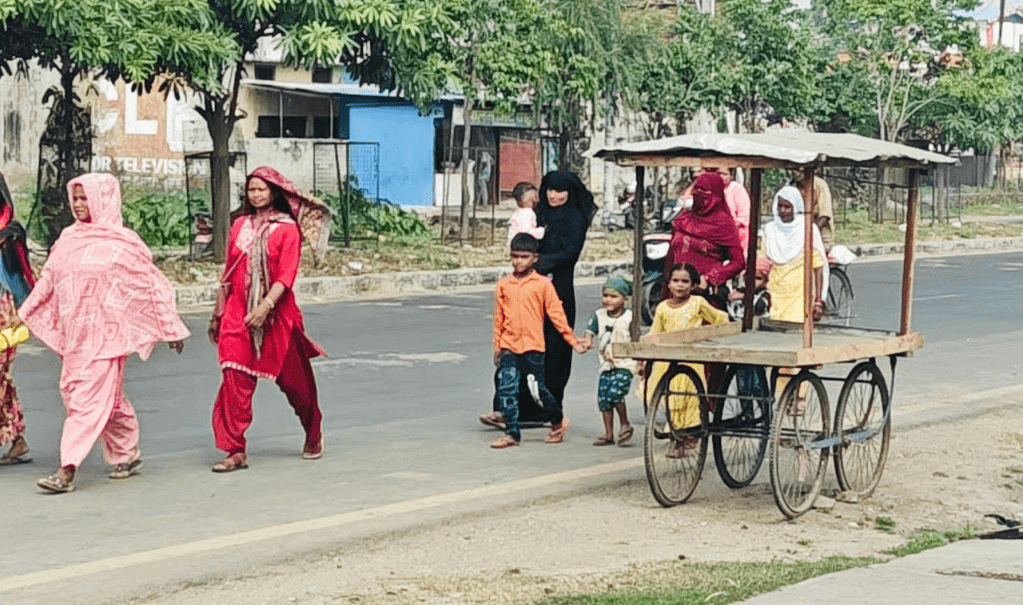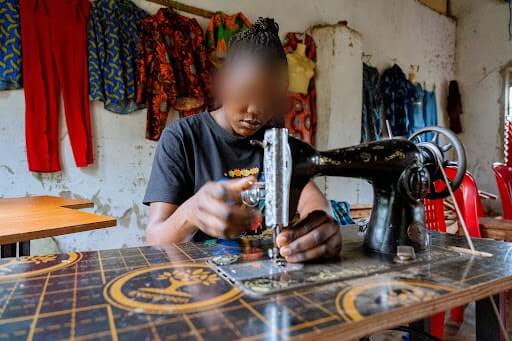“When I was just 9 years old, I was forced into marriage.“
So said Sakhi, one of our rescue agents in South Asia. The pain of her childhood is one of the reasons she’s so passionate about helping girls and young women today.
“My aunt made the decision for me,” she said.
When her parents died, young Sakhi went to live with her aunt and uncle. Her aunt hoped marrying Sakhi off would relieve some of her struggling family’s financial stress. “She thought it was the right thing to do, but I was too young and scared.”
Isolated and oppressed, Sakhi passed through adolescence and into her teen years without the love and support of her parents, burdened with a load of household and conjugal responsibilities to her “husband.”

I suffered a lot in that marriage,” she said. “My husband was not kind and would often hurt me… I felt scared and confused during those years.”

South Asia is home to the largest number of child brides of any region worldwide (Image is representational of a South Asian street)
Injustice swathed in good intentions
Her story is a microcosm of the plight facing millions of girls around the world. UNICEF estimates that there are around 650 million girls and women who were married as children in the world today, and goes on to state that despite the staggering number, the practice “is an egregious violation of every child’s right to reach her or his full potential.”
While more countries are outlawing marriage to minors, as evidenced by UNICEF above, the practical difficulties of living in poverty have kept the practice alive. Like Sakhi’s, many families facing desperate circumstances are just trying to do what’s best for their children.
Lucas is our rescue manager in the Dominican Republic, a country that just outlawed early marriages in 2021. He understands that for struggling families, marrying their girl child off early may seem like their only option.
“Often in these cases… there is an exchange taking place between the minor’s family and the adult who is marrying the minor,” Lucas said. “Sometimes the family may receive land, livestock, money, etc, from the adult. Sometimes, the family doesn’t have the resources to support the minor, and they know that if they marry the minor off, (she) will be well-fed and protected by the adult she is marrying.”
In locations lacking oversight, parents can pursue their child’s early marriage without seeking permission from authorities; oftentimes, the marriage can proceed without any governmental approval. While the exchange may be financially beneficial in the short term—even sometimes meaning the difference between life and death for other members of the victim’s family in terms of survival and starvation—the price is often a child’s freedom.

The family will benefit, and the adult who is marrying the minor will benefit. The child, however, will always pay the price and suffer,” Lucas said.
Erasing childhood
Dr. Blake, Destiny Rescue project director in South Asia, agrees with Lucas’ assessment: “Once married, these young girls often find themselves confined to their husband’s home, tending to his needs and those of his family. This locks away opportunities for self-reliance and dignity… she has little to no agency in the decisions that shape her life.”
It’s a reality that Sakhi experienced firsthand. “I had no freedom to study or choose my life. I had to follow his rules.”
While the loss of agency effectively stalls a child bride’s life, the physical toll of early marriage can actually threaten it.

My husband beat me,” Sakhi said. “I became pregnant when I was only 15 and gave birth to my first child.”
Instead of securing her safety, early pregnancies and an increased threat of domestic violence can make child marriage deadly. Becoming pregnant so near adolescence greatly increases the risk of complications for both mother and baby.
It’s a tough situation to escape, especially without help. Child brides like Sakhi are socially isolated, mentally and emotionally repressed and physically exhausted, all while under the impression that they’re doing the right thing for their families.
This isn’t a sweet tale of high-school sweethearts eloping for start a new life together; these kids are forced to sacrifice their childhoods and bodies for financial stability, often without their consent or a full understanding of what marriage entails.
Despite financial needs or cultural norms, child marriage is often nothing more than institutionalised child abuse.
Escaping the facade
Thankfully, the world has made great strides in recognising that fact. We interviewed Destiny Rescue teams on three continents, and they all said the same thing: while child marriage still exists in one form or another, their individual societies and governments condemn the practice.
Our teams across the globe see child brides like any other exploited child but with a particularly complex rescue process. To avoid burning bridges with certain communities, agents must delicately dismantle entrenched social customs to bring those children to freedom. Their expert knowledge of the local culture and the desperation that fuels early marriage allows them to rescue children while bringing their families on board in the rescue process.

Access to education is widely recognised as the most significant factor in delaying the age of marriage for girls (Image: A trafficking survivor in Uganda receives tailoring training)
In Uganda, our team rescued a 14-year-old girl with aspirations of becoming a doctor when her parents planned her marriage to pay unexpected medical bills. In the Dominican Republic, caseworkers spent weeks helping a newly rescued young bride understand that she would survive without her husband’s financial support. A girl in South Asia fled an arranged child marriage and found not just sanctuary, but solutions with our team there; skill training empowered her to support herself financially—to choose her own future.
Sakhi’s escape was more difficult. Frustrated that his wife hadn’t produced a son, her husband sent the pregnant 16-year-old and her baby daughter away. While life was an uphill battle for her, Sakhi finally had room to grow. “Every hardship taught me to be brave,” Sakhi said. “I learned to never give up.”
Now, Sakhi rescues other girls and young women so they won’t have to suffer the way she did. “I know how hard life can be, and I want to give them the love and support I didn’t have,” she said. “I hope for a brighter future for them, where they feel loved, safe and have the chance to grow and dream.”
Would you like to give the gift of rescue to a suffering child? Your donation is of inestimable worth to a girl whose entire future is at stake. Fill out the form below to rescue a child today.


 US & International
US & International Australia
Australia New Zealand
New Zealand